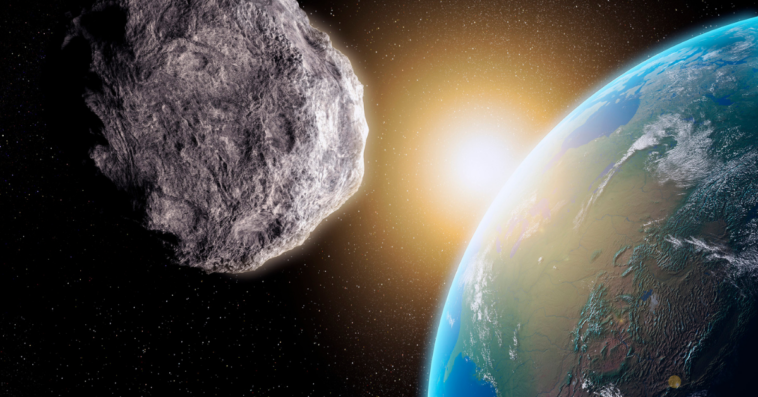NASA has issued an alert regarding a massive asteroid, named 2020 DB, which is expected to make a close flyby of Earth in September 2024. The asteroid, measuring approximately 525 feet in diameter—roughly the size of a football stadium—will pass within 4.6 million miles of Earth. While this may sound alarming, NASA’s scientists have confirmed that there is no threat of collision. However, the event is significant for researchers and marks a valuable opportunity to study near-Earth objects (NEOs).
What We Know About Asteroid 2020 DB
Asteroid 2020 DB was first discovered in 2020 and has been monitored closely by NASA ever since. Its size and proximity to Earth qualify it as a “potentially hazardous asteroid” (PHA), a designation given to objects that come within 4.6 million miles of Earth and are large enough to cause significant damage if they were to impact the planet.
2020 DB’s estimated size—approximately 525 feet in diameter—is comparable to famous landmarks like the London Eye or the Statue of Liberty. Although the asteroid will not collide with Earth, it will be classified as a “close approach,” meaning it will be studied intensely by NASA and other space agencies to better understand the behavior of near-Earth objects.
NASA’s Planetary Defense and Monitoring System
NASA’s Planetary Defense Coordination Office (PDCO) is responsible for tracking and monitoring asteroids like 2020 DB. The PDCO works to detect and characterize any NEOs that pose a potential threat to Earth. Their work involves close monitoring and detailed modeling of an asteroid’s trajectory, size, and composition to ensure early detection of any risks. The PDCO uses both ground-based telescopes and space-based monitoring systems to track objects like 2020 DB and calculate their potential paths.
NASA’s commitment to planetary defense extends to a series of missions designed to study and mitigate asteroid threats. For example, the DART Mission (Double Asteroid Redirection Test), which successfully redirected an asteroid in 2022, is a testament to the agency’s efforts to develop practical solutions for asteroid defense.
Close Approach: Understanding the Risks
While 2020 DB’s flyby will bring it within 4.6 million miles of Earth, this is still a safe distance. To put it in perspective, the Moon is approximately 238,855 miles from Earth, so the asteroid will be almost 20 times farther away than our closest celestial neighbor. However, due to the asteroid’s size and its proximity, the event is considered a significant “close approach.”
NASA classifies asteroids as potentially hazardous not because of an imminent threat but because of their size and proximity to Earth. These objects are carefully monitored as part of NASA’s long-term efforts to safeguard the planet. Asteroids that measure over 500 feet in diameter and pass within 4.6 million miles of Earth are capable of causing widespread damage in the rare event of an impact. However, the chance of this happening remains extremely low, and no such event is predicted for the foreseeable future.
Why NASA Tracks Asteroids
Monitoring asteroids is a critical component of NASA’s planetary defense strategy. Even though impacts are rare, the consequences of a large asteroid collision could be catastrophic. The most famous asteroid impact, which is believed to have caused the extinction of the dinosaurs, occurred 66 million years ago and had a devastating global effect.
Asteroid impacts today are much less likely, but smaller impacts, such as the 2013 Chelyabinsk meteor in Russia, demonstrate the importance of monitoring. The Chelyabinsk event resulted in an explosion that damaged buildings and injured over 1,000 people, despite the asteroid being only about 65 feet in diameter—significantly smaller than 2020 DB.
NASA’s monitoring allows scientists to not only predict potential impacts but also develop strategies for deflecting or mitigating any potential risks. With technological advancements, NASA aims to ensure that humanity is prepared for any asteroid that might come too close for comfort in the future.
Upcoming Opportunities for Study
Although 2020 DB poses no threat, its close approach presents a unique opportunity for scientists to study the asteroid up close. As it approaches Earth, telescopes and radar systems will be used to gather data on its composition, size, shape, and rotation. Studying these features helps scientists better understand how asteroids form and behave in space.
Additionally, NASA’s upcoming Near-Earth Object Surveillance Mission will enhance the agency’s ability to detect and monitor more asteroids like 2020 DB. This mission aims to expand NASA’s surveillance network, making it easier to identify smaller and potentially more dangerous asteroids before they come close to Earth.
Planetary Defense in Action
NASA’s attention to asteroids like 2020 DB is part of its broader planetary defense mission. In 2022, NASA made history by successfully testing its asteroid deflection technology through the DART Mission, which aimed to demonstrate the possibility of altering an asteroid’s trajectory.
While the technology is still in its early stages, the success of the DART Mission has provided valuable insights into how scientists can prepare for the unlikely event of a hazardous asteroid impact in the future.
Conclusion: No Immediate Danger, but Continued Monitoring
Though the stadium-sized asteroid 2020 DB will make a “close approach” in September 2024, there is no cause for alarm. NASA has confirmed that the asteroid poses no immediate danger to Earth. However, the event is a valuable opportunity for scientific research, helping astronomers improve our understanding of near-Earth objects and refine techniques for planetary defense.
By closely monitoring 2020 DB, NASA continues to lead the way in planetary defense, ensuring the safety of our planet from potential asteroid impacts. As we continue to advance in space exploration and defense technologies, events like this provide essential opportunities to test our capabilities and learn more about the cosmos.
For more information and future updates on asteroid 2020 DB’s flyby, stay tuned to NASA’s Planetary Defense Coordination Office or check their website for real-time updates on near-Earth objects.








Comments